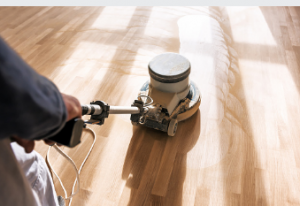Posted on February 14, 2022
Floor Sanding Guide
There are many factors to consider before floor sanding. First of all, it is important to make sure that the floor is clean. This applies to new wood floors and scrubbing between grits in the big machine. This will eliminate any wild scratches. Also, it is important to sand in a specific order, starting with the highest grade of sandpaper and avoiding grades 50 and 80.
 Before sanding the floor, be sure to take out all the furniture. Next, check the floor for nails or screws. Having them protrude from the floor can cause massive damage to your sander and could tear the sanding belt. To avoid this, make sure to empty the trash before sanding the floor. After this, you can move on to the next step, finishing the floor.
Before sanding the floor, be sure to take out all the furniture. Next, check the floor for nails or screws. Having them protrude from the floor can cause massive damage to your sander and could tear the sanding belt. To avoid this, make sure to empty the trash before sanding the floor. After this, you can move on to the next step, finishing the floor.
Before you begin sanding, make sure that your floor is clean. Sweep it up with a damp cloth and vacuum the floor area. The grit in the sanding pad, disc, or belt may have gotten trapped in the grooves. If this happens, you can end up with a damaged floor. To prevent this problem, you must inspect the floor thoroughly. If there are any cracks or dings, you need to repair them before sanding.
Before floor sanding Adelaide, you should remove all carpets, blinds, and old carpet tacks from the floor. You can leave baseboards in place. If you plan to hire a sanding machine, you must purchase the sandpaper that you will use for the job. You can always return the sandpaper if there is too much. Otherwise, you may end up running out of sandpaper and will have to start over from scratch.
Before sanding your floor, you need to clean it thoroughly. Mop the floor with a slightly moist cloth and vacuum the edges. Dry sanding is the best option for a wood floor. It is the most efficient way to sand a wooden floor. While it takes more time, it is worth the effort. Before sanding, ensure that the floor is dry and free from debris.
If you have a solid hardwood floor, you can try sanding it. However, it is more difficult if the floor is made of laminate. When sanding hardwood floors, you should remove furniture and ensure no exposed screws or nails. These can tear the sanding belt. Be sure to avoid any cracks or holes before sanding. You should also check for cracks in the floor before sanding.
Before sanding your floor, make sure to remove any heating grates and old carpet tacks. If the floor is already painted, you can use finer sandpaper. But you should be sure to follow the manufacturer’s instructions to the letter. You should also be aware of the different types of sandpaper. Depending on the condition of your floorboards, you might have to use a sander with a higher grit.
Before floor sanding, make sure to remove all carpets, curtains, and blinds. This is important for some reasons. If you have carpets or curtains, this could block the sanding machine. Furthermore, you should make sure to remove them before sanding your floors. This will prevent scuff marks and make it easier to polish the floorboards. If you are a beginner, try this method to see if it’s for you.
Before floor sanding, it is important to remove all furniture from the room. You should also check the floor for nails and screws that might rip the sander belt. It is also important to avoid using sandpaper with sharp edges. Then, you should make sure the sander is level to avoid scuff marks on your floors. Once the floor is levelled, you should apply a protective coating.
Floor sanding can improve the lighting of your home. Because sanded floors reflect light, they allow excess light to enter the room. This will not only make the room appear brighter, but it will also reduce your energy bills. This is because the natural light will be available throughout the day, while the artificial light will slowly diminish as the night wears on. Therefore, it is important to avoid excessive amounts of artificial lighting, especially at night.
Go to floorsandingandpolishingadelaide.com.au for more tips.

